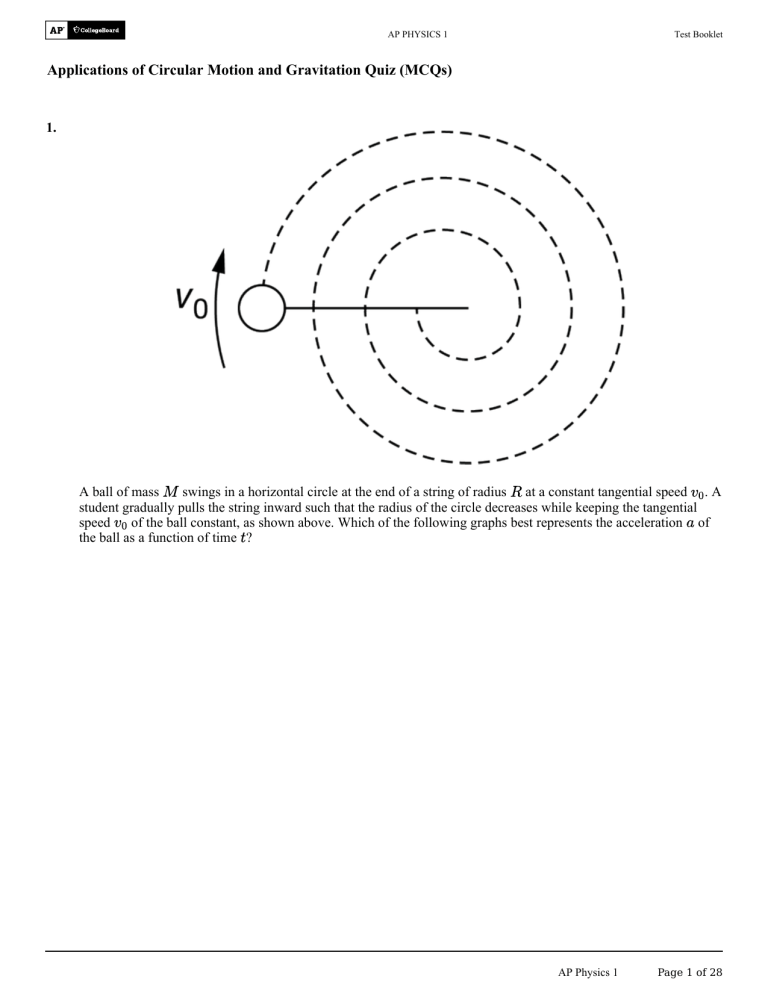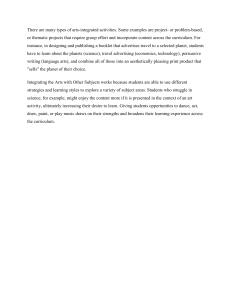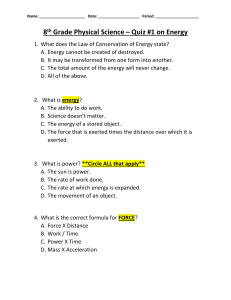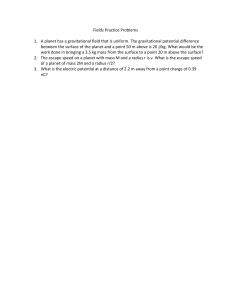
AP PHYSICS 1 Test Booklet Applications of Circular Motion and Gravitation Quiz (MCQs) 1. A ball of mass swings in a horizontal circle at the end of a string of radius at a constant tangential speed . A student gradually pulls the string inward such that the radius of the circle decreases while keeping the tangential speed of the ball constant, as shown above. Which of the following graphs best represents the acceleration of the ball as a function of time ? AP Physics 1 Page 1 of 28 Test Booklet Applications of Circular Motion and Gravitation Quiz (MCQs) (A) (B) (C) (D) Page 2 of 28 AP Physics 1 Test Booklet Applications of Circular Motion and Gravitation Quiz (MCQs) 2. During an experiment, a block of mass is placed on a disk that rotates about an axle through its center, as shown in the diagram. The block is moved to different distances from the axle, and the tangential speed of the block is gradually increased until the mass begins to slip. The distance and maximum tangential speed before , are recorded. A student creates a graph of as a function of , as shown. How should the slipping, student use the graph to most accurately determine the experimental value of the coefficient of static friction between the block and the disk? (A) Determine the slope of the best fit line, and it will be equal to . . (B) Determine the slope of the best fit line and set it equal to (C) Determine the maximum value on the curve and use the data from that point in the equation (D) Determine the midpoint value on the curve and use the data from that point in the equation AP Physics 1 . . Page 3 of 28 Test Booklet Applications of Circular Motion and Gravitation Quiz (MCQs) 3. An object of unknown mass is swung in a vertical circle at the end of a light string, as seen in the figure above. A measurement is made of the object’s tangential speed at the bottom circular path. A student must determine the tension in the string at the bottom of the circular path. Which of the following measurements, in conjunction with the object’s tangential speed, are required to determine the tension in the string? Select two answers. (A) The object’s tangential speed at the top of the circle (B) The object’s mass (C) The diameter of the circular path (D) The time required for the object to complete one revolution Page 4 of 28 AP Physics 1 Test Booklet Applications of Circular Motion and Gravitation Quiz (MCQs) The figure above shows the position of a moon that orbits a planet in an elliptical path. Two specific locations of the moon, position and position , are labeled. 4. In what direction is the net force exerted on the moon? (A) Toward the planet (B) Toward the center of the ellipse (C) Away from the center of the ellipse (D) Parallel to the direction that the moon is moving at any given instant 5. As the moon orbits the planet from position to position exerted on the moon constant? Why or why not? , is the magnitude of the planet’s force due to gravity (A) Yes, because the masses of the planet and moon remain constant. (B) Yes, because the elliptical path that the moon travels around the planet is the same for all revolutions. (C) No, because the tangential speed of the moon is always changing. (D) No, because the moon’s distance from the planet is always changing. 6. An object is released from rest near the surface of a planet. The velocity of the object as a function of time is expressed in the following equation. All frictional forces are considered to be negligible. What distance does the object fall rest? after it is released from AP Physics 1 Page 5 of 28 Test Booklet Applications of Circular Motion and Gravitation Quiz (MCQs) (A) (B) (C) (D) A space station has a mass 7. and orbits Earth in a circular orbit at a height above Earth’s surface. An astronaut in the space station appears weightless because the astronaut seems to float. Which of the following claims is true about the force exerted on the astronaut by Earth? (A) There is no force exerted on the astronaut by Earth because the astronaut is above Earth’s surface. (B) The force exerted on the astronaut by Earth is less than the force exerted on Earth by the astronaut because the astronaut is above Earth’s surface. (C) The force exerted on the astronaut by Earth is equal to the force exerted on Earth by the astronaut. (D) The force exerted on the astronaut by Earth is equal to the gravitational force of the space station that is exerted on the astronaut; the two equal forces balance to cause the astronaut to float. Page 6 of 28 AP Physics 1 Test Booklet Applications of Circular Motion and Gravitation Quiz (MCQs) 8. A planet travels in an elliptical orbit around its star, as shown above. Which arrow best shows the direction of the net force exerted on the planet? (A) (B) (C) (D) 9. A satellite is a large distance from a planet, and the gravitational force from the planet is the only significant force exerted on the satellite. The satellite begins falling toward the planet, eventually colliding with the surface of the planet. As the satellite falls, which of the following claims is correct about how the force that the planet exerts on the satellite changes and how the force that the satellite exerts on the planet changes, if at all? What reasoning supports this claim? (A) and both increase. The gravitational forces that two objects exert on one another decrease as the separation between the objects increases, and these forces are always equal in magnitude. (B) increases while remains constant. The gravitational force exerted by a planet on a satellite decreases as the separation between the two objects increases, and the force exerted by the satellite on the planet remains negligibly small. (C) remains constant while increases. The gravitational force exerted by a planet on a satellite is a constant equal to the weight of the satellite, and the gravitational force exerted by the satellite on the planet decreases as the separation between the two objects increases. (D) and both remain constant. The gravitational forces that a planet and a satellite exert on one another is a constant equal to the weight of the satellite. AP Physics 1 Page 7 of 28 Test Booklet Applications of Circular Motion and Gravitation Quiz (MCQs) 10. object is near a planet’s surface such that the gravitational field strength is A planet attracted to the object? . With what force is the (A) (B) (C) (D) A cart of mass is moving with speed on a smooth track when it encounters a vertical loop of radius , as shown above. The cart moves along the inside of the entire loop without leaving the track. All frictional forces are negligible. 11. Which of the following must be true for the cart to remain on the track when it is at point ? (A) The net force exerted on the cart must be less than the force that the track exerts on the cart. (B) The net force exerted on the cart must be equal to or greater than the weight of the cart. (C) The track must exert an upward force on the cart to prevent it from falling. (D) The track must exert a force on the cart that is equal to the weight of the cart. Page 8 of 28 AP Physics 1 Test Booklet Applications of Circular Motion and Gravitation Quiz (MCQs) 12. A planet travels in an elliptical path around a star, as shown in the figure. As the planet gets closer to the star, the gravitational force that the star exerts on the planet increases. Which statement of reasoning best supports and correctly identifies what happens to the magnitude of the force that the planet exerts on the star as the planet gets closer to the star? (A) The force remains constant because the mass of the planet remains constant. (B) The force increases because it is part of a Newton’s third law pair of forces with the force that the star exerts on the planet. (C) The force decreases because the planet increases its speed as it gets closer to the star. (D) The force fluctuates such that it increases and decreases because the planet does not travel in a perfectly circular path. AP Physics 1 Page 9 of 28 Test Booklet Applications of Circular Motion and Gravitation Quiz (MCQs) 13. An object is released from rest near the surface of a planet. The vertical position of the object as a function of time is shown in the graph. All frictional forces are considered to be negligible. The strength of the gravitational field is most nearly (A) (B) (C) (D) Page 10 of 28 The strength of the gravitational field cannot be determined without applying Newton’s law of universal gravitation. AP Physics 1 Test Booklet Applications of Circular Motion and Gravitation Quiz (MCQs) 14. On the surface of Planet , a object is thrown upward with a speed of . The object’s vertical velocity as a function of time is shown in the graph. Which of the following free-body diagrams represents the gravitational force exerted on the object while it is in free fall? AP Physics 1 Page 11 of 28 Test Booklet Applications of Circular Motion and Gravitation Quiz (MCQs) (A) (B) (C) Page 12 of 28 AP Physics 1 Test Booklet Applications of Circular Motion and Gravitation Quiz (MCQs) (D) 15. A student builds the apparatus shown. One end of a light string is attached to an object of mass , and the other end of the string is passed through a tube and attached to a second object of mass . The student holds on to the tube and swings the object of mass in a horizontal circle while the object of mass remains at a constant to travel around its circular path is . Which of the following height. The time it takes for the object of mass options represents the essential measuring devices needed by the student to collect the necessary data to experimentally determine the gravitational field strength of the object of mass due to Earth’s gravitational field? AP Physics 1 Page 13 of 28 Test Booklet Applications of Circular Motion and Gravitation Quiz (MCQs) (A) Mass balance (B) Mass balance and meterstick (C) Mass balance, meterstick, and timer (D) Mass balance, meterstick, timer, and motion detector 16. Time (s) Vertical Velocity ( ) An astronaut performs an experiment near the surface of a moon by releasing an object at rest above a motion detector such that data can be collected about the object’s vertical velocity as a function of time. The data are provided in the table. Which of the following graphs most likely represents the shape of the curve of the magnitude of the gravitational field strength near the surface of the moon as a function of time? Page 14 of 28 AP Physics 1 Test Booklet Applications of Circular Motion and Gravitation Quiz (MCQs) (A) (B) (C) (D) AP Physics 1 Page 15 of 28 Test Booklet Applications of Circular Motion and Gravitation Quiz (MCQs) 17. A object is released from rest near the surface of a planet. The object’s vertical position as a function of time is shown in the graph. Which of the following procedures can be used to determine the strength of the gravitational field on the planet? (A) Determine the average slope of the graph. (B) Use (C) Use (D) Use 18. . Use . Use for for , for , and . Use for , for and for . Solve for for , for . Solve for , and . for . Solve for . . . If An object is dropped near the surface of a planet such that the gravitational field at the object’s location is , what is the position of the object in relation to the position in the object is thrown upward at a speed of which the object was released and thrown upward after ? (A) below the release position (B) below the release position (C) above the release position (D) above the release position Page 16 of 28 AP Physics 1 Test Booklet Applications of Circular Motion and Gravitation Quiz (MCQs) 19. AP Physics 1 Page 17 of 28 Test Booklet Applications of Circular Motion and Gravitation Quiz (MCQs) A student is riding a Ferris wheel that moves at a constant tangential speed around a vertical circular path of radius , as shown in Figure 1. The student is sitting on a scale. At the instant the moving student is located at point , on the student and Earth exerts a force of magnitude on the the scale exerts a force of magnitude student, as shown in the free-body diagram in Figure 2. Which of the following statements provides reasoning that supports and correctly identifies the magnitude of the force that the student exerts on the scale when the student is at point ? (A) , because that is the magnitude of the force exerted by the scale on the student. (B) , because that is the magnitude of the only upward force exerted on the student. , because Earth exerts a gravitational force on the scale. (C) (D) Page 18 of 28 , because the magnitude of the force exerted on a scale must equal the weight of the person on the scale. AP Physics 1 Test Booklet Applications of Circular Motion and Gravitation Quiz (MCQs) 20. AP Physics 1 Page 19 of 28 Test Booklet Applications of Circular Motion and Gravitation Quiz (MCQs) A student wants to investigate uniform circular motion for an object in an amusement park ride. The student will ride inside of a hollow cylindrical tube that pins the student to the inside wall of the tube as it spins. As the tube spins, the bottom of tube is removed such that the tube becomes open at the top and bottom. At the instant shown in figure 1, the student is pinned against the right side of the tube. A diagram showing the forces exerted on the student is shown in figure 2. When the ride is finished, the student safely falls onto the padded cushions below the floor of the tube. Which of the following represents the magnitude of the force that the student exerts on the right side of the tube? (A) , because the student is in direct contact with the tube. (B) , because the force that the student exerts on the right side of the tube is an action-reaction pair with the normal force that the tube exerts on the student. (C) , because Earth’s gravitational field is continually trying to pull the student down to Earth’s surface. (D) Page 20 of 28 and , because both forces are the result of the student being in direct The vector sum of contact with the right side of the tube and not sliding down. AP Physics 1 Test Booklet Applications of Circular Motion and Gravitation Quiz (MCQs) 21. AP Physics 1 Page 21 of 28 Test Booklet Applications of Circular Motion and Gravitation Quiz (MCQs) A student spins a cup that is in contact with a platform in a horizontal circular path at a constant speed, as shown in Figure 1. The platform is connected to two strings that are held by the student as the platform-cup system experiences uniform circular motion. A free-body diagram of the cup is shown in Figure 2. Which statement of reasoning best supports and correctly identifies the magnitude of the force the cup exerts on the platform? (A) , because this force represents the magnitude of the force of friction between the cup and the platform. (B) , because this force represents the magnitude of the normal force exerted on the cup by the platform. , because this force represents the magnitude of the total force exerted on the platform by the (C) cup. (D) Page 22 of 28 , because this represents the magnitude of the net force exerted on the cup. AP Physics 1 Test Booklet Applications of Circular Motion and Gravitation Quiz (MCQs) 22. A ball that is attached to a string travels in a horizontal, circular path, as shown in Figure 1. At time , the ball has a speed . The forces exerted on the ball at are represented by the free-body diagram, as shown in Figure 2. At a later time , the tangential speed of the ball is increased to . What is the magnitude of the force that the ball AP Physics 1 Page 23 of 28 Test Booklet Applications of Circular Motion and Gravitation Quiz (MCQs) exerts on the string at time ? (A) (B) (C) (D) The answer cannot be determined unless the force that the ball exerts on the string at time is known. 23. An object is spun in a horizontal circle such that it has a constant tangential speed at all points along its circular path of constant radius. A graph of the magnitude of the object’s tangential speed as a function of time is shown in the graph. Which of the following graphs could show the magnitude of the object’s centripetal acceleration as a function of time? Page 24 of 28 AP Physics 1 Test Booklet Applications of Circular Motion and Gravitation Quiz (MCQs) (A) (B) (C) AP Physics 1 Page 25 of 28 Test Booklet Applications of Circular Motion and Gravitation Quiz (MCQs) (D) A planet has two moons, Moon and Moon , that orbit at different distances from the planet’s center, as shown. Astronomers collect data regarding the planet, the two moons, and their obits. The astronomers are able to estimate the planet’s radius and mass. 24. What additional information is needed to determine the time required for one of the moons to make one complete revolution around the planet? (A) The mass of each moon (B) The radius of each moon (C) The distance between the center of each moon and the planet. (D) No additional information is needed. Page 26 of 28 AP Physics 1 Test Booklet Applications of Circular Motion and Gravitation Quiz (MCQs) 25. Distance Speed Force A block of known mass is on a disk that rotates about its center, as shown above. The block does not slip on the disk, and travels at a constant tangential speed when at a distance from the center with a centripetal force of magnitude exerted on it. Which of the following statements about other quantities that might be determined is correct? can be (A) The centripetal force exerted on the block at a larger radius can be determined, since applied using the given known quantities. (B) The centripetal acceleration of the block can be determined, since speed is known and the radius is known. (C) The coefficient of friction between the block and the disk can be determined, since friction provides the centripetal force and the equation can be applied. (D) The total distance traveled by block can be determined by using since the block’s tangential using the known quantities. AP Physics 1 Page 27 of 28 Test Booklet Applications of Circular Motion and Gravitation Quiz (MCQs) 26. A student builds the apparatus shown above. A light string is attached to an object of unknown mass and passed through a tube such that the other end of the string is attached to a second object of mass . By holding on to the tube, the student swings the object of unknown mass in a horizontal circle of radius while the object of mass hanging from the string remains at a constant height. In each trial, the radius of the circular path is changed and the tangential speed of the object of unknown mass is calculated. How can the student determine the value of the unknown mass by using the radius of its circular path and its speed? (A) Use the slope of a graph of as a function of (B) Use the -intercept of a graph of (C) Use the slope of a graph of Page 28 of 28 AP Physics 1 as a function of as a function of (D) Use the -intercept of a graph of . . . as a function of .



